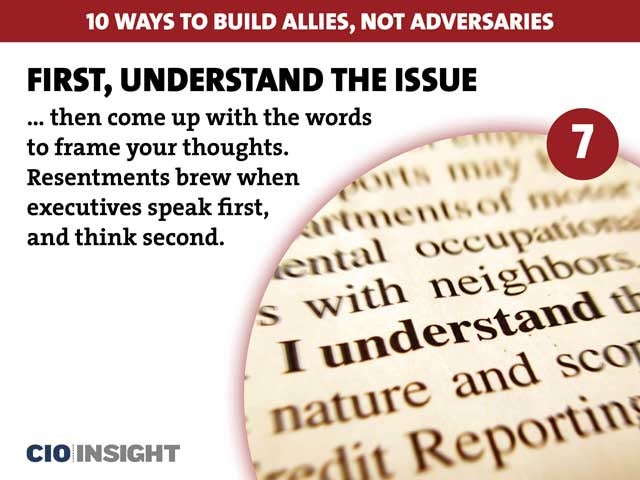
10 Ways to Build Allies, Not Adversaries
 Don’t Confuse “Alliance Building” With “Playing Nice”
Don’t Confuse “Alliance Building” With “Playing Nice”
Yes, positive interpersonal skills matter. But that means making those around you feel like valued winners, instead of trying too hard to be nice.
 Embrace Compromise
Embrace Compromise
Too many senior leaders view compromise as a sign of weakness. But it isn’t a weakness when it keeps initiatives moving and benefits the organization as a whole.
 Set “Calm” as Your Default Setting
Set “Calm” as Your Default Setting
When would-be adversaries get under your skin, that’s when they start to win. Don’t let them.
 Persuade, Don’t Manipulate
Persuade, Don’t Manipulate
Persuasion aims to serve. Manipulation is about control, not cooperation, and it doesn’t work in the long term.
 Appeal to One’s Ego
Appeal to One’s Ego
Good leaders are savvy enough to take advantage of a large ego’s positive qualities (energy, motivation) and minimize the negative ones (selfishness, arrogance).
 Say “No” Without Alienating
Say “No” Without Alienating
Declining a request with “I’m sorry, but I really can’t. But I really do appreciate you’re asking me …” will make the potential adversary feel valued.
 First, Understand the Issue
First, Understand the Issue
… then come up with the words to frame your thoughts. Resentments brew when executives speak first, and think second.
 Praise Opposing Perspectives
Praise Opposing Perspectives
Abraham Lincoln earned a reputation as a skilled lawyer by highlighting the merits of the other side’s case—before presenting his side.
 Don’t Play the “Shame” Game
Don’t Play the “Shame” Game
When you overtly embarrass someone to appear right at that colleague’s expense, you’ve likely made yourself a future adversary. No one needs an enemy.
 Send Handwritten Notes of Appreciation
Send Handwritten Notes of Appreciation
It’s a sure way to build alliances: “Thank you” emails are deleted. Handwritten ones are kept.